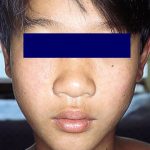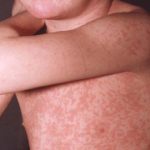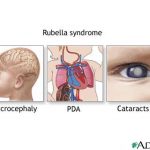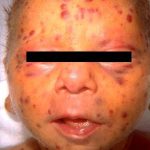- Citas Centro Médico de Caracas: Lunes, Miercoles y Viernes. Pulse el botón Agende una Cita
- Sistema de citas en linea exclusivo para Centro Medico de Caracas en San Bernardino
- Citas CMDLT: Jueves. llamar al 0212-9496243 y 9496245
- Las Emergencias son atendidas en CMDLT previa coordinacion personal al 04142708338
- Proveedor Seguros Mercantil y Sudeban

Rubella is an infectious disease of childhood (especially acquired between 5 and 9 years old, school age, contact with many other children) caused by a virus, the rubella virus. Because it is a childhood infection, 75-85% of women of reproductive age are immune to rubella and should not worry about this disease since acquired immunity lasts a lifetime (anti-rubella IgG antibodies offer permanent protection).
It is a fairly innocuous disease, asymptomatic in most of those affected, manifested with discrete fever, very inconspicuous skin spots and little health impact in the patient
The problem? When suffered for the first time during the first weeks of pregnancy is extremely aggressive against the embryo-fetus and causes severe irreversible damage.
Symptoms
In 50% of cases rubella does not produce any symptoms (asymptomatic), which is why many patients are not aware of having suffered it.
When there are symptoms, they are very mild and therefore rubella is considered a non-aggressive disease in postnatal life:
Day 0, infection : Rubella spreads and is spread through direct contact with nasopharyngeal secretions, saliva and respiratory droplets (from cough) from an infected person (school)
Days 1-9, viral multiplication : The virus passes to the respiratory and lymphatic system of the new host where it multiplies for 7-9 days to generate a sufficient number of viral particles capable of passing into the blood and start generating the manifestations of the virus. disease.
The patient does not have any symptoms.
Day 10-15, virus in blood : The viruses are spread by blood (viremia) to all organs and systems of the body and can be isolated in feces, urine, respiratory and nasopharyngeal secretions.
At this point the patient remains asymptomatic but is already contagious to other people
Day 16-21, symptomatic disease : The first symptoms of the disease appear, manifested by discreet malaise and a reddish maculo-papular rash that is later accompanied by swollen lymph nodes behind the ears and in the back of the neck (lymphadenopathy) and discomfort joints in the knees and fingers
Day 22-28, convalescence : All symptoms have disappeared except for the joint symptoms (which may persist for weeks) and some nodes that can be palpable for life.
The patient no longer manifests disease remains infectious for others during these 7 days.
Day 29-30, healing : Healthy and non-infectious patient for others
How is it diagnosed?
In half of the symptomatic cases it is diagnosed by the particular characteristics of the disease, in both men and women
In asymptomatic persons it is discovered that they suffered rubella due to the presence of specific antibodies during a laboratory examination: almost exclusively in women during preconceptional or prenatal care, an antibody test against rubella (rubella serology) is rarely requested in a man because it has no major medical importance, at least as far as reproduction is concerned.
The only demonstrable way of rubella infection is achieved through the laboratory demonstrating antibodies against the virus or detecting the specific genetic sequences of the virus (a study called PCR: polymerase chain reaction)
Congenital rubella (CRS)
Rubella is a disease almost always mild or asymptomatic but unfortunately has severe effects on a developing embryo, during the first weeks of pregnancy, especially before 13 weeks of pregnancy (I Quarter, 90% of babies will be affected in this period)
Embryo-fetal rubella infection is called Congenital Rubella Syndrome (CRS) and is manifested by the presence of severe structural and functional alterations in the neonate: mental retardation, seizures, motor deficits, deafness, eye injuries (cataracts, chorioretinitis, glaucoma), microcephaly, congenital heart disease, intrauterine growth retardation, visceral growth (liver and spleen) and coagulation disorders, among others. Maternal infection after week 16 seldom affects the fetus.
Which is the treatment?
The SRC has no treatment, affected newborns are treated for their health problems and the sequelae associated with infection, special education, surgery, etc.
What I can do?
- Get vaccinated against rubella at least 3 months before considering a pregnancy if your rubella serology is negative (part of the preconception control).
- Start your prenatal control early or better yet, start a preconception control if you are considering a pregnancy in the future.
- Ask them to practice rubella serology if you are pregnant (prenatal control) so that you know your state of immunity. IgG antibodies suggest chronic infection, old disease or vaccination and IgM antibodies suggest recent infection (3-6 weeks ago)
- Whenever in doubt consult specialists who handle the issue: friends, neighbors or doctors away from the problem can lead you to make serious mistakes such as interrupting a normal pregnancy.
- Make a gift of health to your grandchildren: vaccinate your daughters against rubella.
- Do not expose children or adolescents (or adults) with rubella symptoms if you are pregnant, especially if you do not have rubella immunity.
Rubella injuries according to the stage of pregnancy
1.-Pregnancy less than or equal to 10 weeks (embryo)
Embryo infection risk greater than 90%
Severe injuries: congenital rubella syndrome in its entirety
Increased risk of embryonic death and abortion
2.-Pregnancy of 11 to 12 weeks (fetus)
Fetal infection risk close to 50%
Severe injuries: congenital rubella syndrome in its entirety
3.-Pregnancy from 13 to 16 weeks (fetus)
Fetal infection risk close to 35%
Discrete injuries: almost always the only manifestation is deafness
4.-Pregnancy greater than 17 weeks (fetus)
Risk of infection and very rare fetal injuries, not attributable to the virus
5.-Pregnancy greater than 36 weeks (pregnancy to term)
The rate of infection is high and the newborn baby, even when it does not show the lesions of the CRS can suffer acute injuries compatible with a generalized infection: the baby looks sick, hematological disorders, visceral swelling (liver and spleen) but no typical lesions are described and there are no sequelae as it happens with the CRS.
Rubella in the child, adolescent or adult
Benign infection with very few manifestations and good general condition of the patient. 50% of the people who have suffered the infection never showed symptoms and we know that this was thanks to the serological studies that expose the presence of chronic antibodies (IgG).
Congenital rubella
During pregnancy this virus can have devastating effects on the baby, in fact, the acute infection demonstrated during the first weeks of pregnancy, can be a formal indication for the interruption of it. The diagnosis is not simple and requires multiple assessments and advice.
Fortunately, it is rare to see an acute case during pregnancy due to the fact that almost all women of reproductive age have previously suffered it or have been vaccinated during childhood or adult life in the multiple vaccination campaigns.







